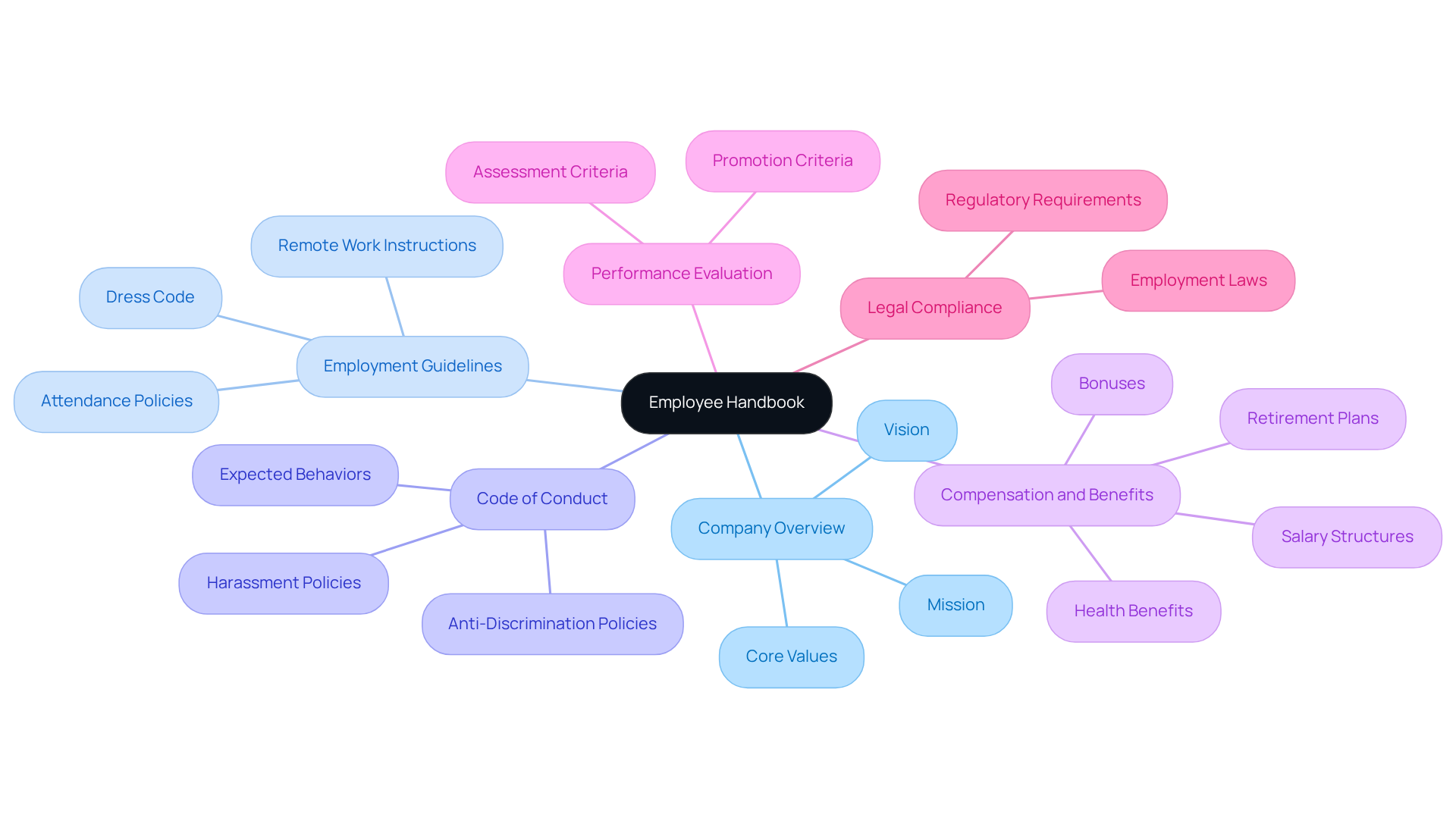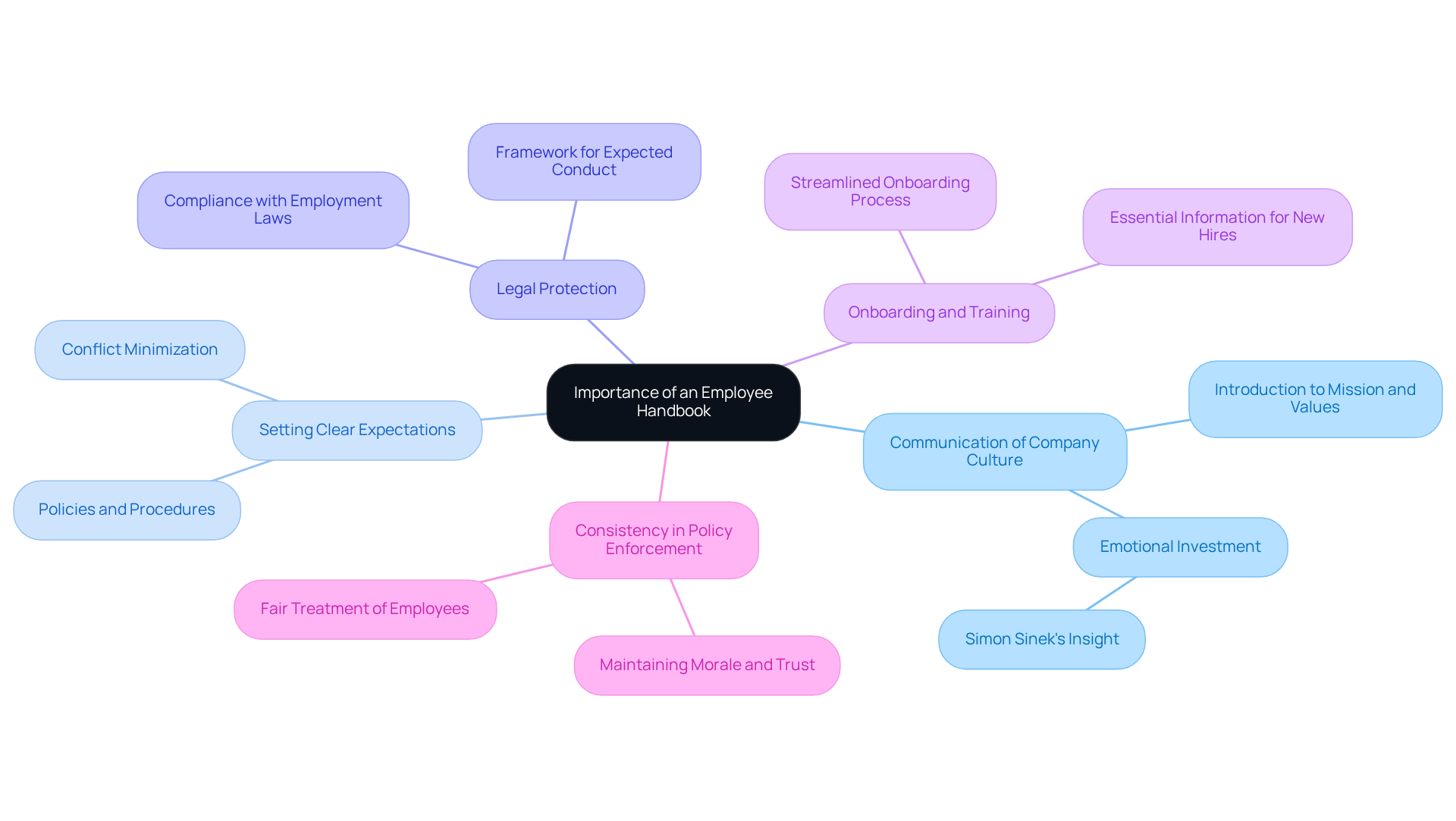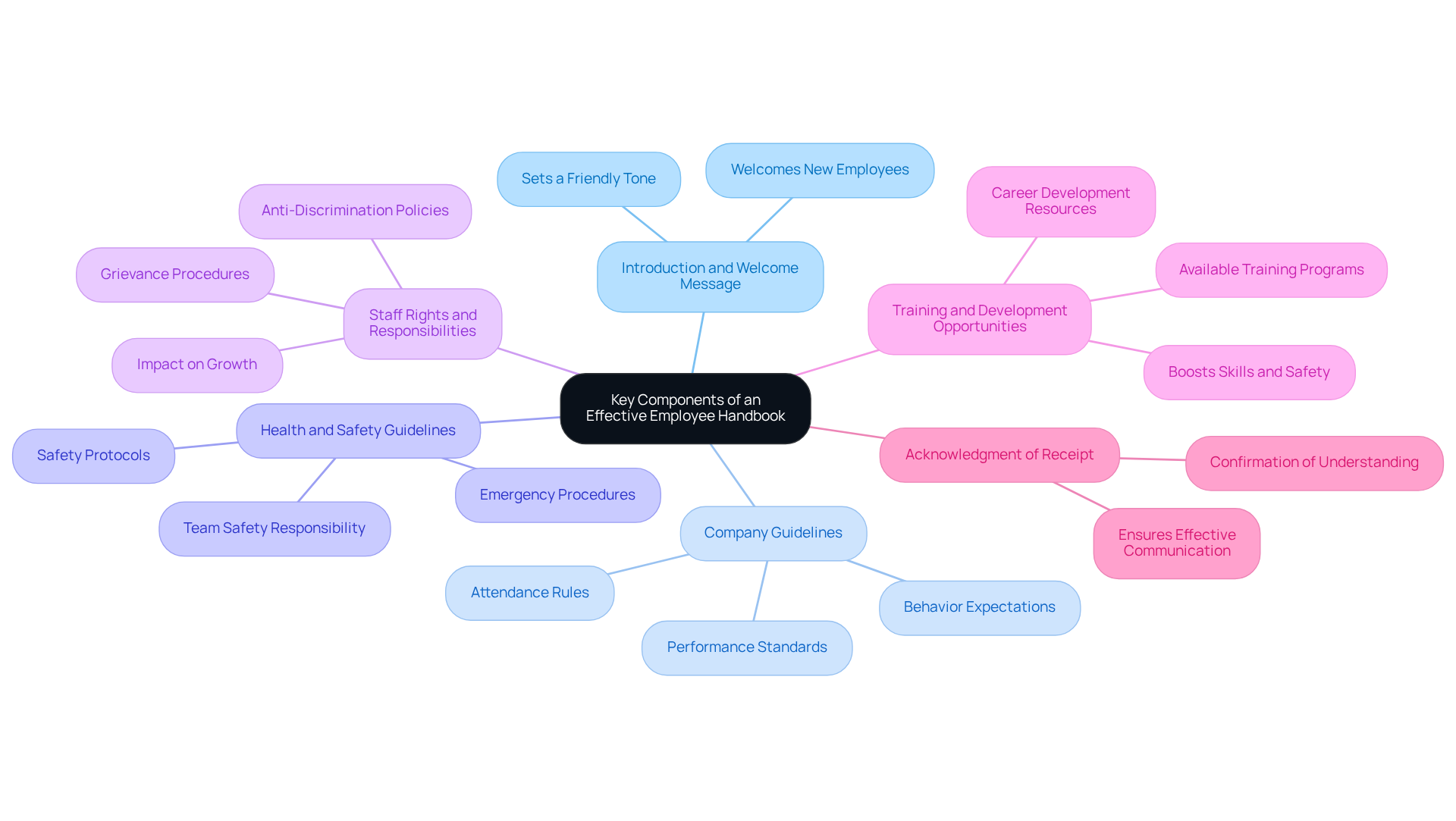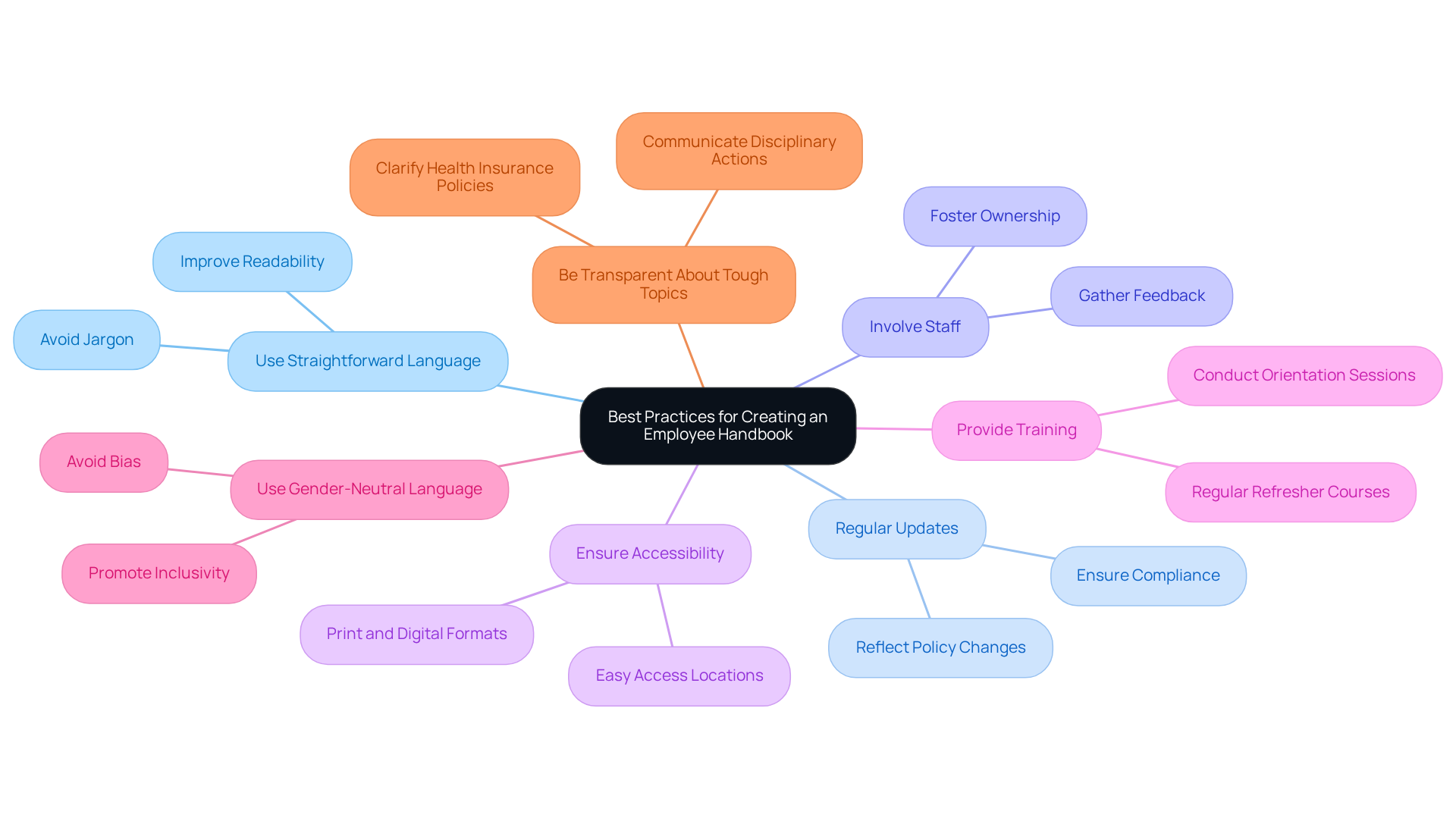
Overview
You might be wondering about the purpose of an employee handbook in organizations. Well, it’s all about providing a comprehensive resource that lays out company guidelines, procedures, and expectations. This not only helps foster a positive workplace culture but also ensures that everyone stays in line with legal requirements.
Now, let’s dive into how this handbook does its magic! It communicates the company values clearly, sets expectations to minimize conflicts, and acts as a crucial tool during onboarding. By doing all this, it ultimately boosts employee engagement and contributes to the overall success of the organization. Pretty neat, right?
Key Highlights:
- An employee handbook serves as a resource outlining company guidelines, procedures, and expectations.
- Key components include company overview, employment guidelines, code of conduct, compensation and benefits, performance evaluation, and legal compliance.
- The handbook communicates company culture, aligning new hires with organisational values.
- It sets clear expectations, reducing ambiguity and potential conflicts in the workplace.
- Legal protection is provided by documenting compliance with employment laws and expected conduct.
- The handbook is crucial for onboarding, enhancing the experience and retention of new employees.
- Consistency in policy enforcement helps maintain morale and trust among staff.
- Best practises include using clear language, regular updates, staff involvement, accessibility, training, gender-neutral language, and transparency about difficult topics.
Introduction
Creating a cohesive workplace culture is no easy task, right? At the core of this effort is the employee handbook—a crucial document that acts as both a guide and a promise to your team. This all-important resource not only lays out a company’s policies and expectations but also plays a key role in boosting engagement and ensuring legal compliance.
Yet, despite its significance, many employees tend to overlook what’s inside, which can lead to misunderstandings and inefficiencies. So, what can organizations do to make sure their employee handbook isn’t just a formality but a powerful tool for communication and culture-building?
Let’s explore some ideas together!
Define Employee Handbook: Core Elements and Structure
You might be wondering what exactly the purpose of the employee handbook is and why it’s so important. Well, consider the purpose of the employee handbook as your go-to resource that lays out a company’s guidelines, procedures, and expectations for everyone on the team. Let’s break down some key components you’ll typically find in one:
- Company Overview: Here’s where you get a quick intro to the organization, including its mission, vision, and core values. This is super important for making sure everyone is on the same page regarding the purpose of the employee handbook and aligned with the company’s goals.
- Employment Guidelines: This section dives into the nitty-gritty of office regulations, covering everything from attendance and dress code to remote work instructions. Shaping a positive work environment is one of the key purposes of the employee handbook.
- Code of Conduct: This part outlines the expected behaviors for staff, with a strong emphasis on anti-discrimination and harassment policies. It’s all about fostering a respectful workplace culture.
- Compensation and Benefits: Here, you’ll find details about salary structures, bonuses, health benefits, and retirement plans. It’s crucial for staff to understand the purpose of the employee handbook, which details what they’re earning and what perks are available.
- Performance Evaluation: This section lays out how staff performance will be assessed, including promotion criteria. Setting clear expectations is key to fulfilling the purpose of the employee handbook, which is to help everyone grow in their careers.
- Legal Compliance: This ensures that the company is following local, state, and federal employment laws, keeping both the organization and its staff protected.
Now, let’s talk about the layout in relation to the purpose of the employee handbook. It should be clear and organized, often featuring a table of contents for easy navigation. Why is the clarity regarding the purpose of employee handbook so crucial? Well, research shows that 60% of staff members tend to skip reading their company guide, which can lead to misunderstandings and inefficiencies. By providing a well-organized guide, organizations can boost staff engagement, which aligns with the purpose of the employee handbook, helping everyone understand their roles better and leading to a more productive and harmonious workplace. Plus, did you know that firms with updated staff manuals are statistically one-third more likely to grow compared to those without? That really highlights the purpose of the employee handbook in achieving organizational success! Tools like Waybook can also help make the manual more organized and accessible, making it easier for staff to find the information they need.

Explain the Importance of an Employee Handbook in Organizations
You might be wondering just how significant the purpose of the employee handbook really is for organizations. Well, it’s quite profound, serving multiple essential functions that can make a real difference:
- First off, think about the communication of company culture. The handbook is like a warm welcome for new employees, introducing them to the company’s culture, mission, and values. This foundational understanding helps align new hires with the organizational ethos right from day one. As Simon Sinek points out, when team members are emotionally invested in the company culture, they're more likely to contribute positively to its mission.
- Next up is setting clear expectations. By outlining policies and procedures, the guide lays down clear expectations for employee behavior and performance. This clarity helps reduce ambiguity and minimizes the potential for conflicts, making for a more harmonious workplace.
- Let’s not forget about legal protection. A well-crafted handbook serves as a protective shield against legal disputes. It documents compliance with employment laws and provides a clear framework for expected conduct, which can be crucial in mitigating legal risks.
- Now, consider onboarding and training. The handbook is an invaluable resource for onboarding new hires, giving them the essential information they need to get settled into their roles swiftly and effectively. This streamlined process enhances the overall onboarding experience, leading to higher retention rates.
- And then there’s consistency in policy enforcement. By ensuring that all staff are treated fairly and uniformly, the handbook plays a critical role in maintaining morale and trust within the workplace. This consistency is vital for fostering a positive organizational culture.
In essence, the purpose of the employee handbook extends beyond mere regulatory compliance; it serves as a strategic asset that enhances organizational efficiency, fosters a positive work atmosphere, and aids in adhering to legal standards. With statistics showing that only one-third of staff are engaged at work, the importance of a well-organized handbook in boosting engagement and alignment with company culture becomes even clearer. For instance, Daxko's staff manual effectively conveys its culture in a way that’s easy to grasp, showcasing the perks of a well-designed guide. So, how’s your organization handling its handbook? It might be time to take a closer look!

Key Components of an Effective Employee Handbook
What is the purpose of an effective employee handbook? You might be wondering what key components should be included to fulfill the purpose of an employee handbook. Let’s break it down together!
- Introduction and Welcome Message
This is your chance to set a friendly tone and warmly welcome new employees to the team. - Company Guidelines
Clear and concise rules about behavior, attendance, and performance expectations are essential. Think of this as the roadmap for your workplace culture. - Health and Safety Guidelines
This is crucial! You know, spills and slips are among the most common workplace injuries. So, comprehensive info on safety protocols and emergency procedures can really make a difference. Remember, safety is a team effort! Everyone needs to be in the loop about safety regulations to keep the workplace safe. - Staff Rights and Responsibilities
This section should outline staff rights, including anti-discrimination policies and grievance procedures. Did you know that organizations with updated staff manuals are one-third more likely to grow? That just shows how important it is to have clearly defined rights and responsibilities. - Training and Development Opportunities
Provide details on available training programs and career development resources. When you involve staff in ongoing education, it not only boosts their skills but also enhances overall workplace safety and efficiency. - Acknowledgment of Receipt
This is a simple document for staff to sign, confirming they’ve received and understood the manual. It’s all about ensuring everyone is on the same page, which is key for effective communication.
By including these components, you’re not just ticking legal boxes; you’re fulfilling the purpose of the employee handbook by fostering a culture of transparency and accountability. Prioritizing health and safety can significantly cut down on workplace injuries, many of which are preventable. As the saying goes, "Carefulness is free, while carelessness can have severe consequences." So, let’s make sure we’re all careful!

Best Practices for Creating an Employee Handbook
What is the purpose of the employee handbook in creating an effective guide for employees? Following some best practices can significantly enhance the purpose of the employee handbook.
You might be thinking, how can I make this handbook clear? Well, using straightforward language is key. Ditch the jargon and complex terms—this way, everyone can easily understand what’s inside. Did you know that research shows 60% of employees don’t read their company guidelines due to poor communication? That’s a big reason to prioritize clarity!
Now, let’s talk about regular updates. It’s super important to consistently review and refresh the guide to reflect any changes in policies, laws, or even the company culture. In fact, a staggering 75% of small businesses fail to revise their guidelines, which can lead to outdated information and compliance issues.
Have you considered involving your staff in the process? Including them in the development or updates of the manual ensures it addresses their needs and concerns. This kind of engagement fosters a sense of ownership and highlights the purpose of the employee handbook as a more valuable resource.
Accessibility is another biggie! Make sure the guide is available in both print and digital formats so that everyone can refer to it whenever they need to. When it’s easy to access, it encourages regular discussions, which are crucial for understanding the regulations.
And don’t forget about training! Conduct sessions to help staff get familiar with the manual’s contents and how to use it. This proactive approach can really enhance their understanding and adherence to the policies.
Using gender-neutral language is also a must. It promotes inclusivity and ensures that everyone feels represented in the handbook.
Lastly, be transparent about the tough topics. Clearly communicating challenging issues—like disciplinary actions and health insurance premiums—helps build trust and understanding among your staff.
By implementing these best practices, you can create a handbook that serves the purpose of employee handbook by not only informing but also nurturing a positive workplace culture. This, in turn, contributes to improved employee engagement and retention. So, are you ready to dive in and make your employee handbook a fantastic resource?

Conclusion
You might be wondering why an employee handbook is such a big deal. Well, it’s not just a bunch of rules—it’s the heartbeat of your organization! It lays down the core values, guidelines, and expectations that really shape your workplace culture. By clearly laying all this out, the handbook boosts communication and creates a sense of belonging among employees, helping everyone align with the organization’s mission and goals.
Let’s dive into some key insights. An employee handbook has a multifaceted role. It sets clear expectations for behavior and performance, offers legal protection, and acts as a go-to resource for onboarding and training. Plus, it ensures that policies are enforced consistently, which is super important for building trust and keeping morale high. And let’s not forget the stats that show how a well-crafted handbook can lead to increased employee engagement and organizational growth—talk about significance!
Ultimately, think of the employee handbook as more than just a regulatory document; it’s a strategic asset that can really drive success. By focusing on clarity, accessibility, and inclusivity while creating and maintaining the handbook, organizations can foster a positive work environment that meets legal requirements and boosts employee satisfaction and retention. So, it’s time for organizations to recognize the transformative potential of their employee handbook and invest in making it a comprehensive and engaging resource for everyone on the team.
Frequently Asked Questions
What is the purpose of an employee handbook?
The employee handbook serves as a resource that outlines a company’s guidelines, procedures, and expectations for all team members.
What are the core elements typically found in an employee handbook?
Core elements include a company overview, employment guidelines, code of conduct, compensation and benefits, performance evaluation, and legal compliance.
What information is included in the company overview section?
The company overview provides a brief introduction to the organization, including its mission, vision, and core values.
What topics are covered under employment guidelines?
Employment guidelines cover office regulations such as attendance, dress code, and remote work instructions.
What does the code of conduct section address?
The code of conduct outlines expected behaviors for staff, emphasizing anti-discrimination and harassment policies to foster a respectful workplace culture.
What details can employees find in the compensation and benefits section?
This section includes information about salary structures, bonuses, health benefits, and retirement plans.
How does the performance evaluation section function in the employee handbook?
It outlines how staff performance will be assessed, including criteria for promotions and setting clear expectations for career growth.
Why is legal compliance important in an employee handbook?
Legal compliance ensures that the company adheres to local, state, and federal employment laws, protecting both the organization and its employees.
How should an employee handbook be organized for effectiveness?
An effective employee handbook should be clear and organized, often featuring a table of contents for easy navigation.
What impact does a well-organized employee handbook have on staff engagement?
A well-organized handbook can boost staff engagement by helping employees understand their roles better, leading to a more productive workplace.
What statistical advantage do firms with updated employee handbooks have?
Firms with updated employee handbooks are statistically one-third more likely to grow compared to those without.
👍
What others are liking
5 Steps to outline your ideal documentation structure
5 MINS READ
Where to start the your journey of mapping out your ideal documentation structure, aligning it with the very heartbeat of your organization?
Defining a winning level of detail in your process
3 MINS READ
What is too much detail, and what is too little? This article described in that winning level detail about what detail is enough.





